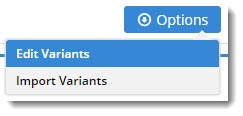...
The CMS stores a list of Variants (e.g. 'Size') and their associated Values (e.g. 'Small', 'Medium', 'Large') in a table. This lookup table is referenced when you add a variant to a master product. You'll see an example of how a bit later; for now let's look at populating the data.
- In the CMS, navigate to Settings → Feature Settings.
- Edit the Product Variant feature.
- Hover over the 'Options' button and select 'Edit Variants'.
- Click 'Add' and enter a Variant in the input field.
- Click 'Save'. Once the variant has saved, the button will update to 'Values'.
- Click 'Values' and then click 'Add' to add a value.
- 'Save' and repeat to add another value. Continue until all values have been entered.
- Click 'Back' to exit values maintenance and return to your Variant list.
- You can repeat this process for any other Variants you may require, such as Colour, Capacity, Weight, Length, and so on.
| Tip |
|---|
You'll also be able to enter new variants and values on the Product Maintenance screen, so don't worry if you haven't thought of EVERY option right away. Saving a new variant or value against a product will add the optoion(s) to these lists. |
3. Maintain Master Products
Now you're ready to set up some variants!
- In the CMS, navigate to Products & Categories → Product Maintenance.
- Search for the required product and click 'Edit'.
- At the bottom of the maintenance page, you'll find a new section labelled 'Master Product'.
- Toggle the 'Is Master Product' setting on. Additional maintenance fields will appear.
- The 'Child Products' section is where you set up the child options for this master product.
- To set up the first child, either search for the product code to be used as the child SKU, or leave blank to use the master code for pricing.
- Enter the Variant name in the first Variant box. The dropdown list will be populated as you type, with data from the 'Edit Variant' screen we visited in section 2. Select the correct option, or enter a new one.
- Next, enter the Variant Value in the corresponding box. Again, the dropdown list will be populated from values in the lookup table. Handy!
- If there is another variant applicable to this product, enter it on the next line, repeating steps 7 and 8.
- If there is a third variant dimension available, click the 'Add Variant' button.
- Once all variants have been entered, click 'Add Child Product'.
| Info |
|---|
Product Variant data can also be imported in bulk - especially handy if you're starting from scratch. A guide on importing variants can be found here XXXXXXLINKXXXXXX. |
...




